|
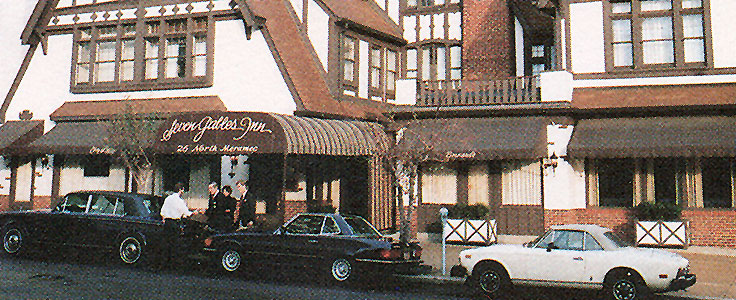
Chez Louis / Bernard's
Morton Louis Meyer was born in St. Louis on
January 25, 1931. After graduating from Princeton University in
1952, he served in the army during the Korean War.
Because of his fluency in several languages,
Meyer was sent to the U.S. Army language school in California, where
he scored the highest mark ever on the school's exam. He was shipped
to Germany for training and then to eastern France as a
counter-intelligence agent. While in France, Meyer developed a love
for travel, art and French food.
On June 14, 1954, while still in the service,
Meyer married Roxanne Harris of Highland Park, Illinois. They would
have three children ― Nancy, Danny and Tommy.
Danny Meyer went on to become a renown New York
restaurateur. In his autobiographical book, Setting the Table,
Danny looked back at his father's life from an adult perspective.
My parents, Roxanne
and Morton Louis Meyer, had spent the first two years of their
youthful marriage in the early 1950s living in the city of
Nancy, capital of the French province of Lorraine, where my dad
was posted as an army intelligence officer.
In 1955, at the conclusion of my
dadís overseas military service, my parents were still very much
in love with each other and with Europe. Their knowledge of and
fondness for France in particular was a powerful bond between
them. In St.
Louis my father parlayed his love of all things French into a
career as an innovative and successful travel agent.
Meyer joined the William H. Goldman Travel
Agency, which was started by Goldman in 1919. In 1956, the agency
was incorporated as the Goldman-Meyer Travel Agency, with Meyer as
secretary-treasurer. When Goldman retired in 1958, Meyer became
president of the firm. Meyer's brother, Richard, would become vice
president.
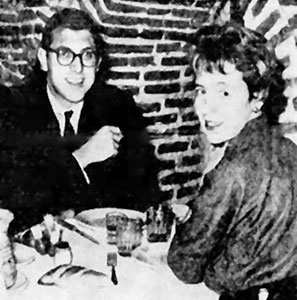 |
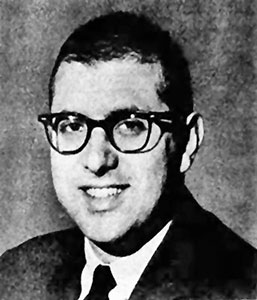 |
Morton
& Roxanne Meyer
St. Louis Post-Dispatch, Dec 9, 1958 |
Morton
Meyer
St. Louis Post-Dispatch, Feb 27, 1959 |
In 1960, as large commercial jets began
transporting Americans overseas, Morton Meyer developed Open Road
Tours.
His agency, Open Road
Tours, packaged customized driving trips, often in conjunction
with Relais de Campagne, a network of lovely family-operated
inns around France. This was long before such excursions off the
beaten path became common in the travel industry. Dad exulted in
planning these driving tours of the countryside; heíd note
exactly where travelers would stumble upon a certain vineyard, a
worthwhile museum or a particularly good bistro. His clients
loved his attention to detail; his business thrived.
Meyer's love for Europe extended into his home,
enveloping Danny and his siblings.
At home, too, he and
my mom were Eurocentric. They often hosted cocktail parties and
dinner parties for friends and business colleagues from France,
Italy and Denmark, who either were in town on business or had
made a detour to St. Louis just to see us. For several years our
house was home to the grown children of French innkeepers. By
day these young people would help out in Dadís office with
translations and administrative tasks, and by night they would
act as au pairs for my sister, Nancy, my brother, Tommy, and me.
French was always being spoken around
the house, either by our guests or by my parents (who used it at
the dinner table especially when they wanted to discuss
something not meant for our ears). Our neurotic, inbred French
poodle, Ratatouille, was named after my dadís favorite Provencal
dish.
Meyer lived life to the fullest, with a
propensity for risk taking.
My father was
unquestionably my childhood hero: a hedonist, a gastronome and a
man who cherished and passionately savored life. He loved the
excitement and risk of the racetrack and gave me a taste for it,
even when I was too young to place bets legally.
Dad also took risks as a businessman.
He was always coming up with exciting new ideas based on his
love of travel and food, and on his constant drive to share his
finds with others. At one point Open Road Tours had offices and
staffs in Chicago, Los Angeles, New York, and Paris. Later, it
opened offices all over Europe.
But disagreements between Open Road's inside
and outside investors, and suits filed by the Hertz Corporation seeking
to collect money they were owed, forced Open Road to file for
bankruptcy.
I never fully
understood how or why, but sometime in the late 1960s, when I
was still a young boy, Open Road Tours went bankrupt. I remember
abundant tears and shame, but few details. I heard comments
like, "We expanded too quickly."
My paternal grandparents were torn
apart too. Their only two sons had been in business together ―
my father as president and his younger brother as vice
president. Whatever events had led to the bankruptcy had also
driven a sharp wedge between the two brothers.
My mother was anguished, and her
disappointment and disapproval were apparent. Business details
were not openly discussed, but the familyís bruises were deeply
felt.
Undeterred, Meyer switched from the travel
business to managing hotels in Italy.
In 1970, when I was
twelve, my father leaped into the hotel business in Italy.
Despite the pleas of my mother, and with her father's begrudging
help in the form of a $1 million loan, he committed himself to
long leases on one hotel in Rome and another in Milan. He was
certain that becoming a hotelier would be his ticket to fortune.
My mom maintained that it promised
nothing more than protracted absences from home. There was
always some reason my dad had to go to Italy. Each time the
hotel workers went on strike, he flew to Rome or Milan to help
make beds. Business flagged and lagged, and although he was
spending half a month at a time away from his family to address
problems, it inevitably proved impossible for him to operate a
hotel business across two continents. At an enormous financial
cost and an even greater emotional cost, my father finally found
a buyer for his two leases. He then went on to his next idea.
While in Italy, Meyer noticed that most Italian
hotels operated at an 80-percent occupancy rate between Easter and
November 1st, and at a 20-percent occupancy rate the rest of the
year. The discrepancy disturbed him and he became determined to find
a way to lure travelers in the off-season.
In 1972, still
irrepressibly optimistic, my father created another new
business, called Caesar Associates. This new company would sell
packaged group tours at a deep discount for a very narrow niche
of travelers known as interliners ― airline employees and their
families. Interliners could fly standby at unbelievably low
rates. Dadís business model was simple but original. He
aggregated all the discounts to which interliners were entitled
and packaged trips lasting up to two weeks.
In addition to low airfares, he
negotiated rock-bottom rates for hotels, ground transport,
sightseeing, shopping and dining. The value he added was to
offer highly imaginative itineraries and use the underlying
buying power of group travel to create an extraordinary rapport
between price and quality. He hired sparkling young tour guides
at each destination, and he kept his clients informed of travel
opportunities by writing an endless stream of marketing
collaterals.
Caesar Associates actually thrived for many years, with outposts
in London, Paris, Copenhagen, Madrid, and Rome. But this success
wasnít enough for my father. Having failed to learn some
critical lessons from his earlier business failures in the 1960s
and 1970s, he gambled the fortunes of his entire business on
another new one, involving risky and questionable real estate
and hotel deals back in St. Louis.
 |
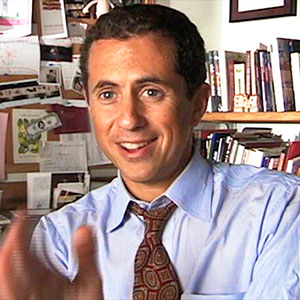 |
|
Danny Meyer |
Morton Meyer entered the Clayton real estate
market in 1977
when a banker friend suggested he needed to shelter
earnings from his travel business. His initial purchase was the
Mortgage Building at 7730 Forsyth.
In October of 1979, Meyer plunged into the
restaurant business. He opened Chez Louis at 26 North Meramec in
Clayton. The storefront space in the 53-year-old Seven Gables
Apartment Building had previously housed the Clayton Coffee Company.
Meyer owned Chez Louis with Bernard Douteau, who served as
the restaurant's chef and general manager. Douteau, born
in a small town south of the Loire Valley, had worked as a hotelier
in France, as will as in Ethiopia and Italy. In Italy he managed two
hotels for Meyer, whom he had met five years earlier in Paris.
Chez Louis featured white tablecloths with
pastel napkins, heavy service plates and handwritten menus. Colorful prints and posters punctuated white plaster
walls.
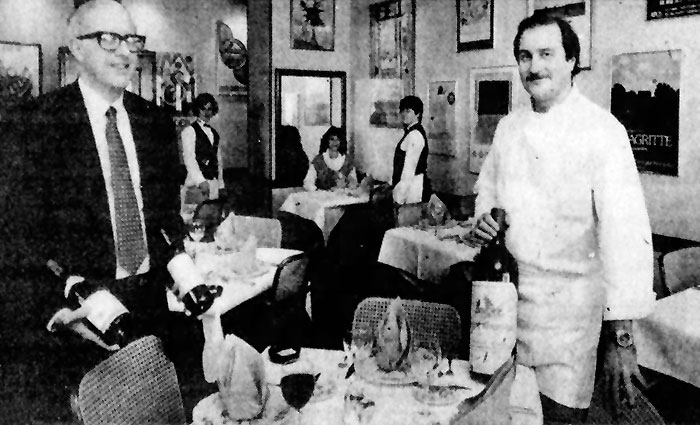 |
Morton
Meyer (left) and Bernard Douteau at Chez Louis
St. Louis Post-Dispatch, Nov 22, 1984 |
Chez Louis' menu was small and changed
frequently. Restaurant critic Joe Pollack provided an
overview of
the cuisine in his March 25, 1982 St. Louis
Post-Dispatch review.
The Chez Louis
cuisine style is French, kind of a happy compromise between the
truly haute cuisine, which can be overwhelmingly rich, and the
truly nouvelle, in which a food processor grinds everything into
the texture and taste of baby food. Sauces are light, with a
beautifully modulated touch of herbs and spices and a base that
involves the reduced stock of the meat or fish. Vegetables are
cooked quickly to retain color and flavor.
And then there's the presentation,
which is glorious. Each morsel is perfectly arranged on the
plate, colors are right and the feeling can be that the dish is
too pretty to eat Ė until the first whiff of savory herbs
tingles the palate and stimulates the salivary glands.
 |
 |
1984
Chez Louis Menu
(click image to enlarge) |
Chez
Louis Interior
|
In November of 1982, Meyer and Douteau opened a
second restaurant which they named Bernard's. It was located
adjacent to Chez Louis, in the 18 North Meramec space of the Seven
Gables Apartment Building.
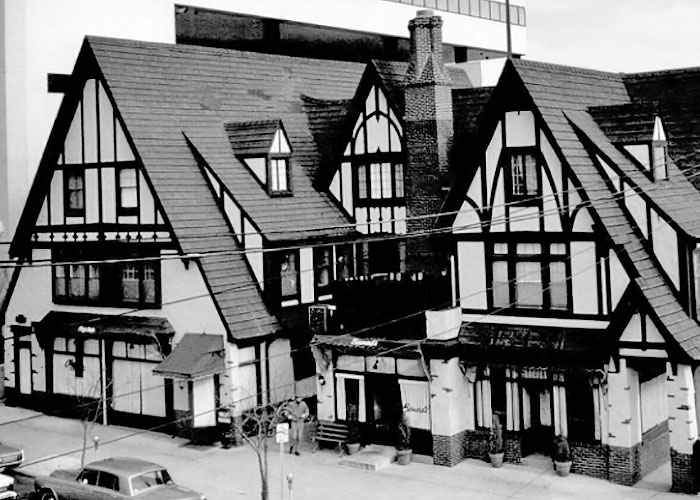 |
| Chez
Louis and Bernard's, Seven Gables Apartment Building,
circa 1983 |
Bernard's was an informal 50-seat French
bistro. Its understated decor was much the same as Chez Louis, with
cream-colored walls adorned with colorful framed posters from Paris
art galleries. The ceiling was beamed and windows were trimmed with
little cafe curtains. Seating was on plain bentwood chairs at
bistro-style marble-top tables, with a few dark blue banquettes.
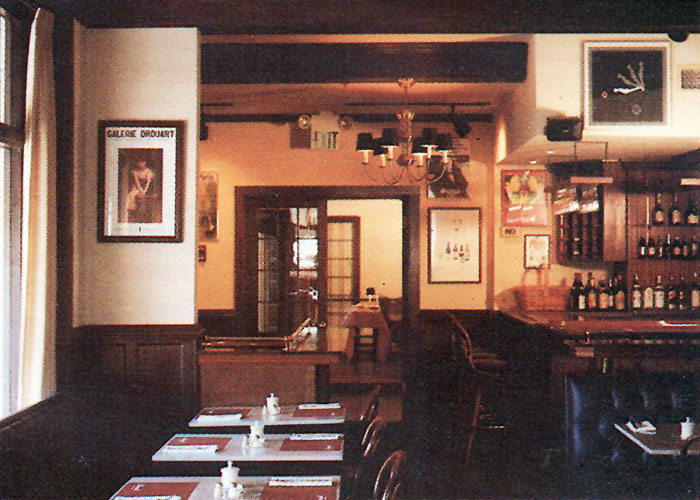 |
|
Bernard's Interior |
Douteau wanted Bernard's menu to be simpler
than the more formal Chez Louis.
At Chez Louis we had a menu that takes a lot
of preparation. I always felt we should offer the simpler foods that
are most common in France. They may sound pedestrian to some, but
these are the dishes many French people still eat every day.
The one-page menu included onion soup, crepes,
quiches, croque monsieur, salade Nicoise, terrines and charcuterie. There
were at least two specials a day, which could include a hearty cassoulet of meat, lentils and flageolets, or a spicy veal stew
simmered in white wine.
Douteau introduced the southern French
specialty
pan bania on Bernard's menu.
Knowing the appeal of
salads for Americans and, of course, sandwiches, I thought it
would be fun to present a salad sandwich.
The inside of a hard round roll or bun was
scooped out and filled with Boston lettuce, olives, tomatoes,
potatoes, hard-cooked egg, capers and a vinaigrette dressing, with
an anchovy option.
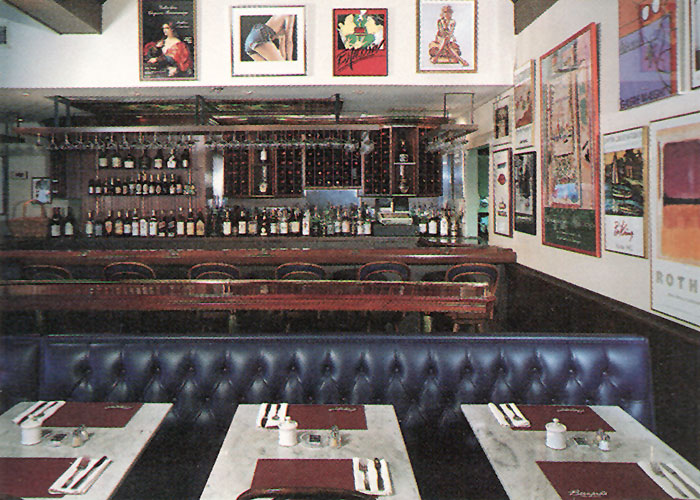 |
|
Bernard's Bar |
In December of 1983, Meyers and Douteau opened
Bernardís Food Boutique at 10 North Meramec. According to Douteau,
the gourmet marked started out as a charcuterie.
The concept of a
charcuterie is still strange to St. Louis. The way people live
here is more leisurely than, say, New York or Chicago. They
don't feel the necessity to come to a specific shop to buy
specific types of prepared foods.
Bad habits are easier than good ones,
you know. It is easier to get all your food items at one place.
Americans are not like Europeans who go to each little store and
specify the exact items they want.
The boutique featured an assortment of salamis,
hams, smoked duck, smoked chicken, Canadian bacon and cheeses. The
pastry counter offered a selection of cookies, tarts, pastries and
other sweets. There were croissants, baguettes and assorted breads.
Olive oil, teas, flavored vinegars and mustards were also available.
Bernardís Food Boutique was short lived. It
closed early in 1985.
* *
* * *
In April of 1985, Meyer purchased the Seven
Gables Apartment Building. Along with Douteau and Garrett Balke, a
St. Louis developer, he turned the 60-year-old Tudor-style building
into a 32 room hotel. They named their hotel the Seven Gables Inn.
When the Inn opened at the start of 1986, the
concrete-paved alleyway which ran between the two halves of the
H-shaped building had been removed. In its place, dark brown ceramic
tiles were laid and glass walls constructed on the ground level at
the front and rear to form an enclosed lobby. The lobby provided
access to Chez Louis and Bernard's on either side, and the
streetside entrances were closed. A 50-by-30-foot outside area in
the back of the lobby was landscaped and opened as the Garden Court
for outdoor dining.
Douteau explained the reason for incorporating
the two restaurants as part of the Inn.
It's a natural
extension to marry the restaurants with a small hotel. In
Europe, food is the main reason for the success or failure of a
hotel, while in this country it's often neglected with the rooms
becoming the focal point.
 |
| Seven Gables Inn,
circa 1990 |
In August of 1987, Meyer acquired the Daniele
Hotel at 216 North Meramec in Clayton. The price was $4.6 million.
As part of a $1 million renovation program, the hotel's dining room
was renamed the London Grill.
By September of 1987, in addition to his two
hotels and their associated restaurants, Meyer owned seven office
buildings in Clayton's central business district.
 |
| St.
Louis Post-Dispatch, Sep 7, 1987 |
Meyer
also planed to open a 300-room "world-class" hotel in the heart
of Clayton.
I like doing new
things. We've got a parcel of land. We've also got serious
interest on the part of several chains to manage it. I can't
yet tell you where it will be.
Chez Louis and Bernard's continued to thrive
into the late 1980s. Bernard Douteau was particularly proud of his
namesake restaurant.
I like to think of it
as a classy, little neighborhood joint. It has a life of its own
apart from its neighbor, Chez Louis. While Chez Louis has
tablecloths, fine service and is a creative, fairly
sophisticated restaurant, Bernard's is a bistro serving a simple
tradition of casual food.
We have a good breakfast and lunch
trade ― especially lunch. And to do a good lunch business in
Clayton, you have to have a product that tastes good, is a good
value, is fresh and fast. In the evening, we have a good crowd,
as well, and we're also attracting the late night crowd after
they attend a movie or the theater.
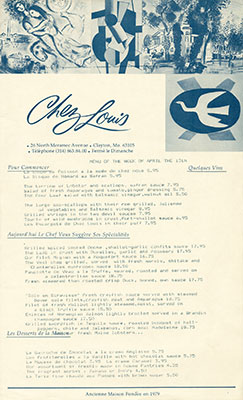 |
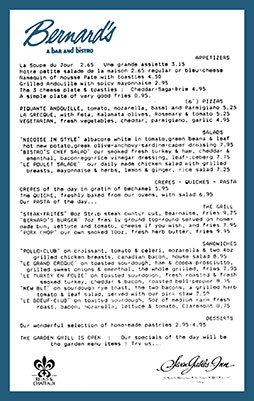 |
1988 Chez Louis Menu
(click image to enlarge) |
1988 Bernard's Menu
(click image to enlarge) |
In September of 1988, Bernard Douteau left the
Seven Gables Inn and its restaurants to "pursue other interests,
including serving as consultant to Whitey's" ― Whitey Herzog's
restaurant at Union Station. Douteau was replaced as executive chef
by his assistant, David Zimmerman.
Zimmerman, a Clayton
native, received an associate's degree in the culinary sciences in
1986 from the Culinary Institute of American, after which he joined
the Seven Gables Inn as first sous chef. He was responsible for
developing menus for both Chez Louis and Bernard's.
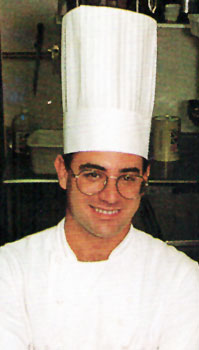 |
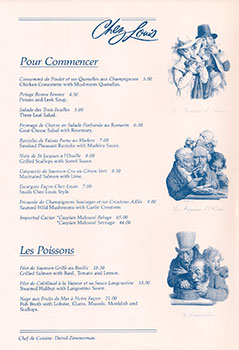 |
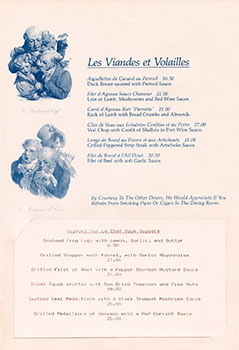 |
David
Zimmerman, 1989
|
1989 Chez Louis Menu
(click image to enlarge) |
In 1988, Meyer announced he would build a 336
room hotel, the Clayton Hilton and Towers, on the southwest corner
of Maryland and Central. But the project faced opposition from
nearby property owners. The hotel was never built.
Morton Meyer died of cancer on July 21, 1990 at
the age of 59. By then, he was once again bankrupt.
Danny Meyer lamented his father's repeated
business failures.
He owned two hotels
in St. Louis, one of which ― the Seven Gables Inn, with its
French restaurant, Chez Louis ― met with critical acclaim. But
the other hotel ― the Daniele Hilton, with its mediocre London
Grill ― was a failure on every count.
My father had leveraged his entire
company to purchase these hotels, and also to purchase a medical
building in Clayton which he planned to reimagine and redevelop
into something big. However, by the time he had emptied the
building of its existing rent-paying tenants, the bottom had
fallen out of the economy. His funders dropped out, but not
before suing him.
Although Dad may have been an
inventive entrepreneur, he did not have the necessary emotional
skills or discipline, and he failed to surround himself with
enough competent, loyal, trustworthy colleagues whose skills and
strengths would have compensated for his own weaknesses. By
1990, shortly before he died of lung cancer at the age of
fifty-nine, he was once again bankrupt. Once again, he had to
inform his family ― his second wife, Vivian, and his three
children and their spouses ― about a failure. We all had a
painful sense of deja vu.
 |
Morton Meyer
St. Louis Post-Dispatch, Sep 7, 1987 |
In 1991, David Zimmerman left Chez Louis and
Bernard's to enter his family's flour business. Michael Holmes
replaced Zimmerman as executive chef.
In January of 1993, it was announced that Chez
Louis had been shuttered and would reopen as an extension of
Bernard's.
In February of 1995, Tim Weaver was named
executive chef of the Seven Gables Inn's dining spaces, including
Bernard's and the Garden Court.
In March of 1998, the owners of Harvest took
over management of the Seven Gables Inn's restaurants, operating
them all under the name Beaux Coo.
Copyright © 2023
LostTables.com
Lost TablesTM
is a trademark of LostTables.com. All rights reserved. |



















